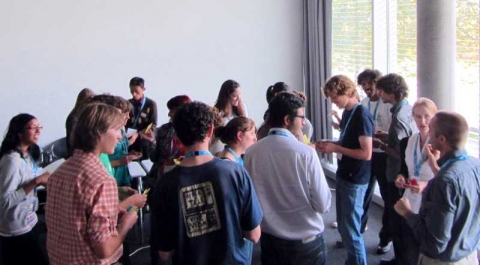You are here
Workshop game 'Trading floor'


Trading Floor by Community Forge is licensed under a Creative Commons Attribution-ShareAlike 3.0 Unported License.
This game is designed to show participants in workshops
- how trade is affected by the availability of money
- the inevitable result of using debt as money
- how money is separate from real value
- how exchange system affects individual and collective behaviors
- how outside control of the money supply can block a local economy
By simulating trading in an actual marketplace, the traders feel the difference, which reinforces the learning objectives. The game is designed to need minimum of materials, but it is useful to have a helper to the faciliator and to plan ahead which rounds to play to make your point.
Basics
Time: Approx rounds with feedback between them will take around 90 minutes.
Player objective: to collect as many seeds as possible by exchanging cards to make sets.
Materials:
- Volunteer to act as cashier
- At least 5 playing cards per player.
- Lots of green pieces of paper.
- Edible seeds or nuts in shells
- Pen and paper for the banker to record loans, and water pistol for defaulters
Preparation
1. Choose which story you want to tell, identify which game architectures to use, and in what order.
2. Set up table and train a cashier to accepts sets of cards, distribute shuffled cards, and give 1 or 2 seeds.
3. Train a banker to issue paper to people's signatures (or facilitator can do this).
Introduction
Cashier gives each player 4 cards and explain that cards are exchanged to make a set. Sets are redeemed by the cashier, one seed normally or 2 seeds for picture cards. Players may only do mutually beneficial exchanges.
Format
Each round consists of the following stages:
TRADE
Settle up / clearing, call in debts (in some rounds)
Count Seeds, count paper.
How do you feel?
Explain next round
Suggested Sequence - 90 mins
Round 1 Direct barter variation
Sets the baseline. No greens issued or even mentioned. Players keep their seeds
Round 2 Debt money variation
Give plenty of time. Push loans. Watch for inflation.
CALL IN DEBTS at the end of the round, and shoot debtors.
Round 3 Fiat Money variation
Reflect then on the value of the green paper, and the role of interest
Reflect:
Which money system is most like the one we use today?
What is the function of interest?
What would happen if seeds could be used to pay debts?
How should the paper be issued in order to create the most seeds?
Variations
Direct Barter
No paper is issued to start.
NB This is very slow
Scarcity
1 green is issued to each player.
NB This is slow
Fiat
2 greens are issued to each player.
NB This is efficient
Commmodity money
1 green issued to each player, greens exchangable for seeds
NB Reluctance to exchange
Commodity-debt money
Give everyone zero greens. They have the option of borrowing 3 from the bank and replaying 4.
Perhaps play for longer to see the effects. Inflation?
NB many players unable to pay back. The bank ends up with the most tokens. Reluctance to exchange?
Mutual Credit
NB. Note how we simulate negative balances with pieces of paper
Each player given 3 greens. Must end with 3 greens.
NB separation of store of value and medium of exchange.
Self issued credit
Users issue as many greens with their name on. All greens must return to issuers at the end.
NB Some players unable to redeem all their credit shows the need for governance!
Bank as Trader
A banker enters the marketplace (with unlimited green slips) buying and selling and earning seeds like other players.
NB Note HOW the odds are stacked in favour of the bank. Prices may go up
Democracy
players decide the rules
NB Don't worry if you never get around to actually trading.
Designed by Sybille Saint Girons & Matthew Slater
